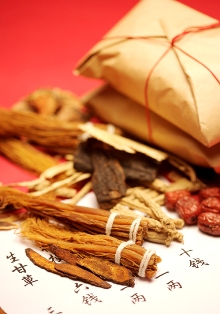Traditional Chinese Medicine Goes High-Tech
Traditional Chinese Medicine Goes High-Tech
“TCM is a set of beneficial practices and knowledge that have been passed on for thousands of years. Its decline is the nation’s loss.” said Chu Fu-lin, Secretary General of the Chinese Medicine Association.
People concerned about the situation have tried to chart TCM to a more scientific direction. Yang Ling-ling, deputy superintendent of China Medical University Hospital’s Center of Translational Research on Traditional Medicine, said, “To support its claims, TCM should provide experimental evidence.” Yang is contributing to this cause through her current project under the Department of Health investigating the exact ingredients of more than 100 varieties of Chinese herbal medicine and their interaction with Western medicine. “Only if TCM adopts a scientific approach utilizing chemical and biological analysis will consumers be convinced of its efficacy, and only then will the world understand its long-established popularity in the Greater China region,” she said.

In 2004 the DOH set out guidelines for the safe delivery of Chinese medicines, requiring hygienic packaging and clear labeling of ingredients, plus limits on residues of pesticides and heavy metals. For concentrated preparations, the DOH pressed for quality control through Good Manufacturing Practice. “In 2005 we started full-scale GMP, which is a quality guarantee system that covers the manufacturing and testing of medical ingredients and pharmaceuticals, as well as medical devices,” said Huang Lin-huang, chairman of the Committee on Chinese Medicine and Pharmacy under the DOH.
“There are now 116 firms following GMP in manufacturing concentrated preparations. Consumers looking for scientific herbal medicine are reassured when they see the GMP label.” The thorniest aspect of overall quality control, however, lies in the fundamental difference between Chinese and Western medical theory. “Western medicine is synthesized in a laboratory, and its use is directed at a specific part of the body,” Yang said. TCM, in contrast, relates the human body to two opposing “chi” in the environment, “yin” and “yang,” and tends to treat the body as a whole, according to Yang. “TCM doctors employ various herbs to restore the balance of yin and yang in the patient and this approach is metaphysical and thus unverifiable,” Yang said.
One of TCM’s most prominent characteristics is the use of multiple herbal ingredients containing yin-yang properties in a single prescription. “This makes it hard to standardize the effects of TCM on the human body,” said Chen Chieh-fu, executive director of the Chinese Traditional Medicine Research and Development Foundation, as the herbs tend to interact with one another, and individuals may respond differently to the mix. Further complications arise when TCM is administered in conjunction with Western medicine, or by individuals not trained in the tradition.
In 2003 Taiwan’s DOH banned the use or import of five herbs containing aristolochic acid, including guang fang ji, and required companies producing herbal concoctions to use scientific methods such as microscopy and thin layer chromatography to identify han fang ji and verify lack of contamination by guang fang ji.
“Some patients may be used to accepting medical treatment without question, but as responsible authorities, we have to provide safeguards and risk-free medical aid,” Huang said.
The DOH took further measures to prevent the inappropriate use of TCM in 2004, coming out with the first edition of “Chinese Herbal Pharmacopoeia,” a book listing 200 materials used in TCM and 200 standard regimens. It details the scientific name of each herb, as well as its form, properties, means of differentiation, methods of examination for adulterants and proper storage techniques, providing information for the scrutiny of herbal materials before they enter the market.
“The promotion of TCM knowledge in combination with stricter regulations is aimed at building a safe environment for patients utilizing these medications and upgrading the relevant industry at the same time,” Huang said. “With these steps and a DNA database of 324 kinds of herbs, we are confident that consumers are protected from damage to their health through mistakenly identified herbs.”
Huang Lin-huang, chairman of the Committee on Chinese Medicine and Pharmacy, says the institution of GMP for concentrated preparations and clinical trials for new drugs are giant strides in TCM’s scientific progress. “In 2005, we certified the first new drug in Chinese medicine - red yeast rice - through the three phases of Investigational New Drug testing. It was found to be rich in cholesterol-lowering substances such as monacolin,” Huang said. “When the essence of TCM and the practice of Western science are integrated, it is good news for everyone’s health,” Huang said. (THN)
Source: http://www.taiwantoday.tw/ct.asp?xItem=165728&ctNode=427